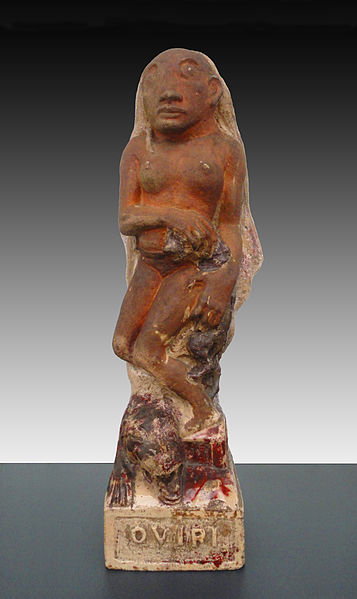Oviri is an 1894 ceramic sculpture by the French artist Paul Gauguin. In Tahitian mythology, Oviri was the goddess of mourning and is shown with long pale hair and wild eyes, smothering a wolf with her feet while clutching a cub in her arms. Art historians have presented multiple interpretations—usually that Gauguin intended it as an epithet to reinforce his self-image as a "civilised savage". Tahitian goddesses of her era had passed from folk memory by 1894, yet Gauguin romanticises the island's past as he reaches towards more ancient sources, including an Assyrian relief of a "master of animals" type, and Majapahit mummies. Other possible influences include preserved skulls from the Marquesas Islands, figures found at Borobudur, and a 9th-century Mahayana Buddhist temple in central Java.
Paul Gauguin, Oviri (Sauvage), 1894, partially glazed stoneware, 75 × 19 × 27 cm (29.5 × 7.5 × 10.6 in), Musée d'Orsay, Paris
First issue of Le Sourire, Journal sérieux, 1899. Louvre, Cabinet des dessins
Siddharta Gautama, 8th century frieze, Borobudur
Relief from a façade in the throne room of Sargon II (Khorsabad, 713–706 BC), showing an Assyrian hero grasping a lion and a snake, Louvre
Eugène Henri Paul Gauguin was a French painter, sculptor, printmaker, ceramist, and writer, whose work has been primarily associated with the Post-Impressionist and Symbolist movements. He was also an influential practitioner of wood engraving and woodcuts as art forms. While only moderately successful during his lifetime, Gauguin has since been recognized for his experimental use of color and Synthetist style that were distinct from Impressionism.
Aline Marie Chazal Tristán, (1825–1867) "The Artist's Mother", 1889, Staatsgalerie Stuttgart
Gauguin's maternal grandmother, Flora Tristan (1803–1844) in 1838
Gauguin with his wife Mette in Copenhagen, Denmark, 1885
Study of a Nude (Suzanne sewing), 1880, Ny Carlsberg Glyptotek








